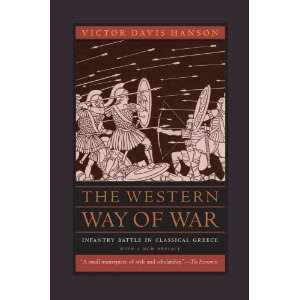I am reading this book to try to really understand Greek hoplite warfare. Matthew has a very different view than that of conventional authors. For example, I had become quite comfortable with Victor Davis Hanson's various studies on the subject such as "The Western Way of War".
I had accepted that hoplites used their spears in over-arm positions to stab at the opposing phalanx. Most model representations of hoplites show such positions when trying to recapture the fighting of the period.
Hughes takes a radically different approach...and has been attacked vigorously by the establishment and historical modelers for challenging the prevailing orthodoxy. I am still carefully working my way through his book, but I am inclined to accept his alternative hypothesis. He says that the vase-images so often used to interpret hoplite warfare are actually stylized versions of warfare in the Heroic (ie pre-hoplite era), or representations of javelin armed troops in combat, not hoplites in a phalanx. He uses vase and other art, literature and physical analysis of how hoplites probably fought to support his arguments.
Why is this work so important? It not only challenges, very assertively, many years of scholarship by numerous respected academics, it also renders inaccurate, if correct, most model figures of the hoplite era. I am interested for both academic and hobby reasons. I'm glad I have not committed many hours yet to building a hoplite army that might be inaccurate. I am also disappointed at how quickly this new work is being dismissed by fellow wargamers, I suspect, without a careful reading. If you accept Matthew, then these Victrix hoplites should be advancing in an oblique position, left leg forward, spears underarm, not overarm.
The TMP community is not, in my opinion, giving Matthew a fair reading. I find his work very thorough and compelling. I have not yet made up my own mind.


